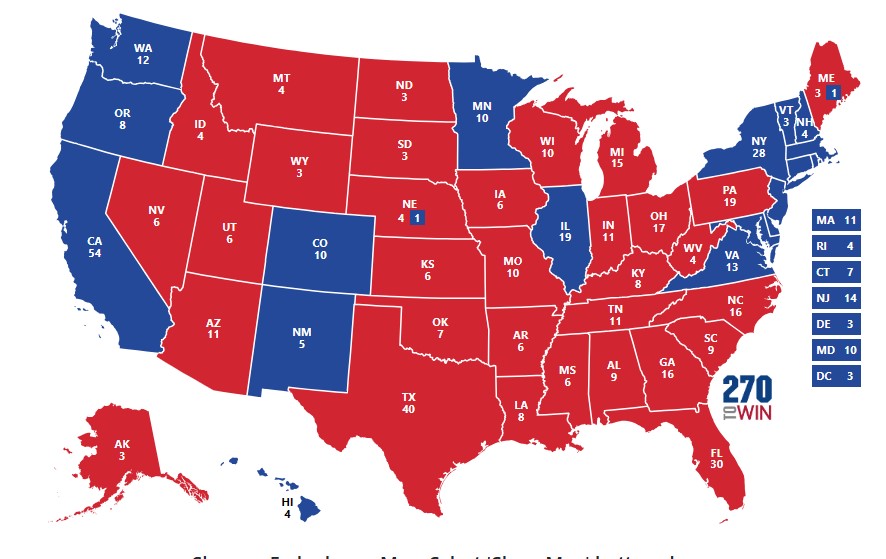As the 2024 presidential election looms, the political landscape is once again dominated by a rematch between Joe Biden and former President Donald Trump. While the national polls may suggest a tight race, the outcome could very well come down to a handful of crucial swing states.
In this comprehensive analysis, we delve into the seven states that are most likely to flip and determine the course of the election: Arizona, Georgia, Michigan, Nevada, North Carolina, Pennsylvania, and Wisconsin. By examining the latest polling data, demographic shifts, and key down-ballot races, we paint a vivid picture of the electoral battleground that will captivate the nation in the months ahead.
Arizona: The Grand Canyon State’s Toss-Up Tussle
Arizona, a longtime Republican stronghold, emerged as a surprise battleground in 2020 when Biden managed to eke out a narrow victory. This cycle, the tide appears to have turned, with Trump holding a comfortable lead of around 6 percentage points according to the latest Decision Desk HQ/The Hill averages.
The border and immigration issues are set to play a pivotal role in Arizona, where voters’ concerns over the ongoing crisis could bolster Trump’s standing. However, Democrats are banking on the state’s recent repeal of a draconian abortion ban and efforts to enshrine reproductive rights protections to energize their base and offset the Republican advantage.
The Senate race between Democratic Rep. Ruben Gallego and Republican Kari Lake is also shaping up to be a closely watched contest, with Gallego currently leading his rival. But with Republicans holding the voter registration edge and Trump’s strong position, the Grand Canyon State remains a true toss-up.
Georgia: The Peach State’s Pivotal Rematch
Georgia, a state that Biden flipped in 2020 by a razor-thin margin, is now firmly in Trump’s grasp. The former president holds a comfortable lead of around 6 percentage points in the DDHQ/The Hill averages, and the New York Times polling puts him ahead by an even wider 10-point margin.
The lack of marquee down-ballot races and signs of the kind of high turnout that buoyed Biden four years ago could pose a challenge for the incumbent. Additionally, Biden will need to energize the state’s significant Black population, as there are indications that he is struggling with this crucial voting bloc nationwide.
While former Georgia Lt. Gov. Geoff Duncan, a Republican, has called on his party not to “fall in line” with Trump, it remains to be seen whether Biden can repeat his 2020 success in the Peach State.
Michigan: The Great Lakes Battleground
In Michigan, another state that Biden carried in 2020, the incumbent is facing a potential protest vote push from progressives and Arab Americans, who expressed their anger in the Democratic primary. This could inspire similar ballot-box boycotts as seen in other states like Wisconsin.
The Arab American community played a vital role in Biden’s 2020 victory, and questions persist over whether this critical voting bloc will return to the Democratic column. With Trump currently holding a 4-point lead in the state, according to DDHQ/The Hill, the Great Lakes State’s sizable Arab American population and large student numbers make it a crucial bellwether for the broader 2024 race.
First Lady Jill Biden’s recent visit to Michigan underscores the importance the Biden campaign places on the state, with the state party chair emphasizing that “the road to the White House runs through Michigan.”
Nevada: The Silver State’s Sun Belt Showdown
Along with Arizona, Nevada could emerge as another major Sun Belt swing state in 2024. Both states boast significant Latino populations, making them a battleground for the candidates’ efforts to court voters of color.
Biden won Nevada by 2.4 percentage points in 2020, but the latest DDHQ/The Hill averages show Trump holding a nearly 7-point lead. The New York Times polling paints an even bleaker picture for the incumbent, with Biden trailing by 12 points in a head-to-head matchup – his worst showing among the battleground states.
The presence of a third-party contender in the Silver State could further erode support for the major-party candidates. Additionally, Democratic Senate candidate Jacky Rosen is performing better than Biden, holding a 2-point advantage over her Republican opponent Sam Brown.
North Carolina: The Tar Heel State’s Tug-of-War
Though Biden swept most of the swing states in 2020, Trump managed to hold onto North Carolina, winning the state by roughly 1.5 percentage points. The Tar Heel State remains a Republican-leaning battleground, according to the nonpartisan Cook Political Report, with DDHQ/The Hill averages showing Trump holding a 4.6-point lead.
Biden’s campaign is determined to flip North Carolina back into the Democratic column, acknowledging the “relentless effort” required to do so. The state’s Democratic governor, Roy Cooper, has expressed cautious optimism about Biden’s chances, noting that the last Democrat to win North Carolina was Barack Obama in 2008.
However, Republicans are grappling with a potential liability in their gubernatorial candidate, Lt. Gov. Mark Robinson, who has faced scrutiny for his past controversial comments.
Pennsylvania: The Keystone State’s Contested Ground
The Keystone State, which Biden won by 1.2 percentage points in 2020, is shaping up to be another fiercely contested battleground. The latest DDHQ/The Hill averages show Trump holding a narrow 1.7-point lead, while recent New York Times/Siena College/Philadelphia Inquirer polling suggests an even wider 3-point edge for the former president.
The primaries in Pennsylvania highlighted vulnerabilities for both Biden and Trump. Nikki Haley’s strong showing, despite having dropped out of the race, served as a warning sign for the former president in the key battleground. On the Democratic side, Biden faced a protest vote push from “Abandon Biden” supporters over the administration’s handling of the Israel-Hamas conflict.
However, the presence of a relatively popular Democratic Senate candidate, Bob Casey, who has consistently run ahead of Biden in polls, could provide a boost for the incumbent. With 19 electoral college votes up for grabs, the Keystone State remains a crucial battleground in the 2024 race.
Wisconsin: The Badger State’s Tight Tussle
Wisconsin, another state that Biden narrowly won in 2020, is now firmly in Trump’s sights. According to the DDHQ/The Hill averages, the former president holds a slim lead of less than 1 percentage point.
A recent Quinnipiac University poll highlighted the potential for third-party candidates to serve as spoilers in the Badger State, with Biden’s lead over Trump shrinking from 6 points to just 1 point when independent contenders were included in the mix.
Biden’s recent visit to Wisconsin, where he touted a major investment by Microsoft, was an attempt to draw a contrast with the unfulfilled Trump-era promises. Meanwhile, the Republican National Convention’s planned return to Milwaukee this summer could provide Trump with an opportunity to make a splash and potentially announce his running mate.
As Trump himself has acknowledged, winning Wisconsin is crucial for the Republican path to the White House. With 10 electoral college votes at stake, the Badger State remains a true toss-up in the 2024 race.




Leave a Comment